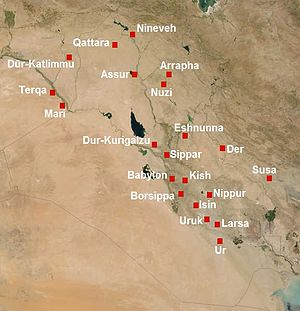Arrapha

Arrapha or Arrapkha (Akkadian: Arrapḫa; Template:Lang-ar) was an ancient city in what today is northeastern Iraq, on the site of the modern city of Kirkuk.[1]
In 1948, Arrapha became the name of the residential area in Kirkuk which was built by the North Oil Company as a settlement for its workers.
History
The first written record of Arrapha is attested from the Neo-Sumerian Empire (c. 22nd to 21st centry BC).[1] Ancient Arrapha was a part of Sargon of Akkad's Akkadian Empire (2335–2154 BC),[2] and the city was exposed to the raids of the Lullubi during Naram-Sin's reign.[3]
The city was occupied around 2150 BC by the Gutians. Arrapha was the capital of the short-lived Guti kingdom (Gutium) before it was destroyed and the Gutians driven from Mesopotamia by the Neo-Sumerian Empire c. 2090 BC.[4][5] Arrapha became a part of the Old Assyrian Empire (c. 2025–1750 BC) before Hammurabi briefly subjected Assyria to the short-lived Babylonian Empire, after which it again became a part of Assyria (c. 1725 BC).
Subsequent to this it fell to the Neo-Sumerian Empire, the Old Assyrian Empire and the Babylonian Empire, and was an important trading center in the 18th century BC under Assyrian and Babylonian rule.[1] However, during the 15th and early 14th centuries BC, it was again a largely Hurrian city, the capital of the small Hurrian kingdom of Arrapha, situated along the southeastern edge of the area under Mitanni domination, until it was fully incorporated into Assyria during the Middle Assyrian Empire (1365–1050 BC) after the Assyrians overthrew the Hurri-Mitanni empire.[1][6][7]
The city reached great prominence in the 11th and 10th centuries BC as a part of Assyria. In 615 BC, seeing the Assyrians occupied with the Babylonians and violent rebellions among themselves, the Median king Cyaxares successfully invaded Arrapha, which was one of the last strongholds of the Neo-Assyrian Empire.[8][9] The region later became part of the Persian ruled province of Athura (Achaemenid Assyria).
Arrapha then fell to the Macedonian Empire, where it became a part of Seleucid Syria in its succeeding Seleucid Empire (Syria being an aphetic form of Assyria[10]). Arrapha is mentioned as such until Hellenistic times, at which point the settlement was refounded under the Syriac name Karka (ܟܪܟܐ).[1]
Between the mid 2nd century BC and mid 3rd century AD, during the Parthian Empire and early Sassanid Empire the site was the capital of a small Assyrian kingdom called Beth Garmai, apart from a brief interregnum in the early 2nd century AD when it became a part of the Roman Province of Assyria.[11] The Sassanids conquered the patchwork of independent Assyrian states in the mid to late 3rd century AD, and Arrapha was incorporated into Sassanid-ruled Assuristan (Assyria) until the Arab Islamic conquest of the mid 7th century AD, when Assuristan was dissolved and Arrapha-Karka eventually became Kirkuk.
Arrapha has not been excavated yet, due to its location beneath modern Kirkuk.[1]
See also
References
- ^ a b c d e f Bryce, Trevor (2009). The Routledge Handbook of The People and Places of Ancient Western Asia: The Near East from the Early Bronze Age to the Fall of the Persian Empire. London and New York: Routledge. pp. 67–68. ISBN 978-1-134-15908-6. Retrieved 27 October 2012.
- ^ Edwards, Charlesworth & Boardman 1970, p. 433
- ^ Edwards, Charlesworth & Boardman 1970, p. 443
- ^ East, William Gordon; Spate, Oskar Hermann Khristian (1961). The Changing Map of Asia: A Political Geography. p. 105.
- ^ Roux, Georges (1992). Ancient Iraq. ISBN 9780141938257.
- ^ Kimmons, Sergeant Sean. "Soldiers Help Preserve Archeological Sites".
- ^ M. Chahin. Before the Greeks, p. 77.
- ^ Martin Sicker. The Pre-Islamic Middle East, Page 68.
- ^ I. E. S. Edwards, John Boardman, John B. Bury, S. A. Cook. The Cambridge Ancient History. p. 178–179.
- ^ Joseph, John (2000). The Modern Assyrians of the Middle East: A History of Their Encounter with Western Christian Missions, Archaeologists, and Colonial Powers. Studies in Christian Mission. Vol. 26. Leiden: Brill. pp. 20–21. ISBN 9789004116412. Retrieved 7 May 2020.
- ^ Mohsen, Zakeri (1995). Sasanid Soldiers in Early Muslim Society: The Origins of 'Ayyārān and Futuwwa. Otto Harrassowitz Verlag. p. 135. ISBN 978-3-447-03652-8.
